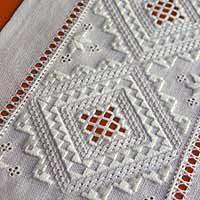|
|
What is Hardanger embroidery?
Hardangersom (or Hardangersaum), is Norwegian for embroidery from Hardanger, and refers to the style of needlework that many of us know as Hardanger embroidery.
Hardanger embroidery is a style of cutwork embroidery that originates from the Hardanger region of Norway. Traditionally, it involves white embroidery on white fabric, where the removal of some of the fabrics threads produce a lacy effect.Traditional Hardanger embroidery
Hardanger was originally worked in bands of embroidery across items such as aprons, shirts, and household linen. It often featured: |  Runner featuring traditional-style Hardanger embroidery designed by Yvette Stanton Runner featuring traditional-style Hardanger embroidery designed by Yvette Stanton
|
|
- diamond, triangular or square motifs of cutwork
- satin stitching in rectangular blocks (kloster blocks) and other shapes
- pulled thread work in the form of four-sided stitch
- cable stitch
- eyelets
- borders of needleweaving and four-sided stitch along each long side of the embroidery (which were usually the top and bottom).
Within the parameters described above, there was a huge amount of room for creativity in design of Hardanger needlework patterns. The designs are hugely varied, and very beautiful. The filling stitches used in the cutwork were still very simple - often just knotted picots,or diagonal twisted bars, or none!
Hardangersom was worked in white linen thread on white linen fabric (or cream on cream) of a single weave i.e. not the double or basket weave of contemporary "Hardanger" fabric.The earliest surviving pieces of Hardanger date from the eighteenth century. It is possible that this style of embroidery was first developed to imitate the Italian needle laces known as punto in aria, reticella, and similar styles of work. However because the Hardanger region is geographically isolated, due to the fjords found there, the style of embroidery developed and became quite distinct.
Contemporary Hardanger embroidery
Contemporary designs are very different to traditional Hardanger needlework patterns. In the last century or so, many changes have occurred in the way Hardanger pieces are designed and worked. Coloured and novelty threads and coloured fabrics are now commonly used. New stitches have been developed, including buttonholed edges. Hardanger sometimes is worked together with other techniques such as cross stitch.
The buttonhole edge so common in contemporary Hardanger did not develop until much later. It is one of the main things that has changed hardanger so much. Traditional Hardanger embroidery designs never used a stitch like this because it would have used up too much precious thread. The buttonhole edge means that Hardanger pieces can now be practically any shape you desire!
I really wanna know about this, anyone can help? can we mixed hardanger with our cross stitch project? which fabric should I choose? thanks :) |
When someone visits this page from a link you share, you will be rewarded
|